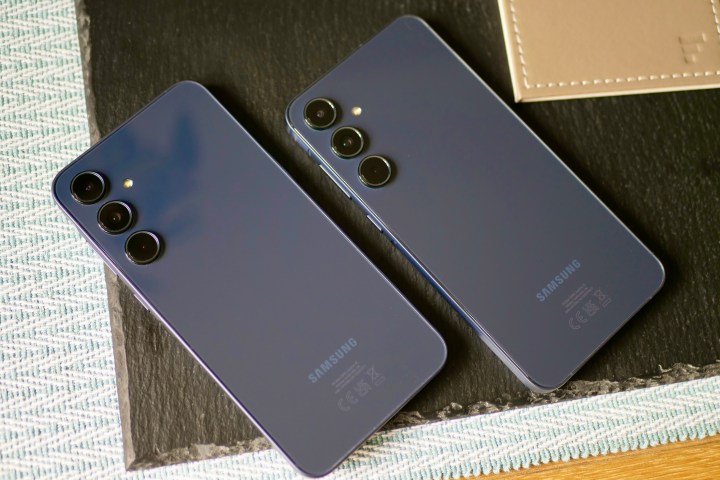
I’ve been using the Samsung Galaxy A55 for almost two weeks and have now swapped my SIM card over to the Samsung Galaxy A35. These are the latest entries in Samsung’s budget-minded Galaxy-A series. In all honestly, I can barely tell the difference between them.
While this sounds like it’s a bad thing, in this case, it may not be so bad for you, the buyer. Confused? Don’t be. Let me explain.
Plastic vs. metal
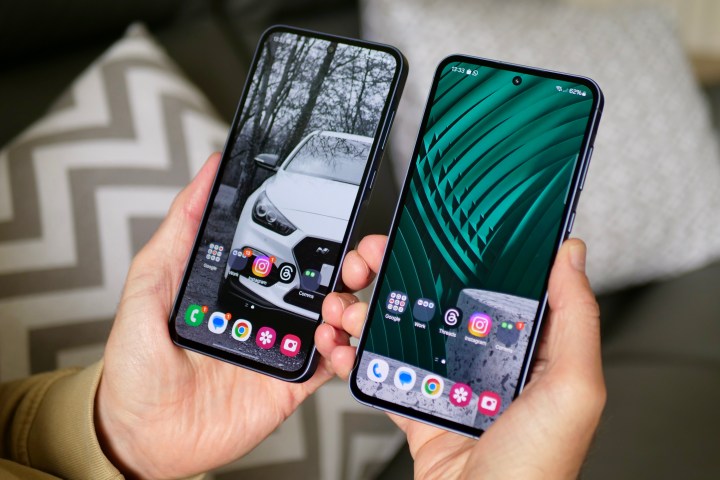
Externally, the Galaxy A35 and Galaxy A55 look basically the same. They have the same screen size, dimensions, and camera module design. Both my review models are also in the same color — Awesome Navy — helping to disguise the fact that they are two different phones. Samsung has used the new, raised section around the volume and power keys to give the shape some character on both phones.
You have to look quite hard to spot the difference and be “in the know.” The Galaxy A55 has a metal chassis finished with a brushed effect that has a slight, but very welcome texture. The Galaxy A35 has a plastic chassis and no textured finish at all, but it does have a subtle metal look to give it some class.
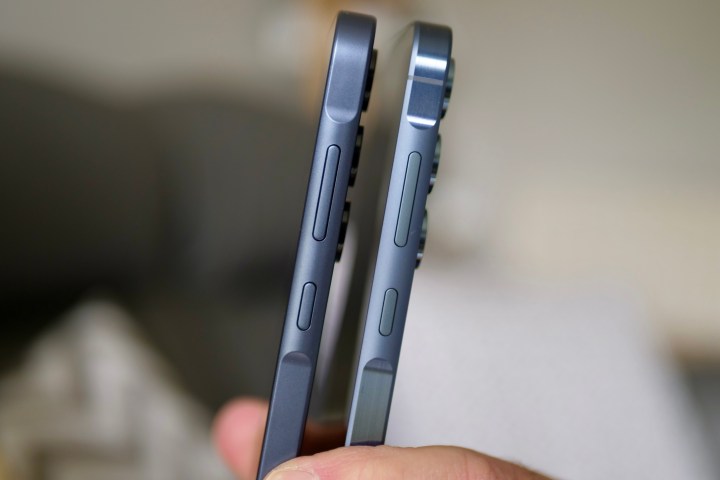
The back of the Galaxy A35 is glass, but not the same glass. It isn’t Gorilla Glass like the Galaxy A55, but I challenge you to actually tell one from the other when you hold the two devices. Sure, you may see the difference should both phones take a tumble — in theory, the Galaxy A55 should be more durable — but just by looking at them, the Galaxy A35 and Galaxy A55 both appear to be the same glass-covered phone.
One of the phones feels better to hold
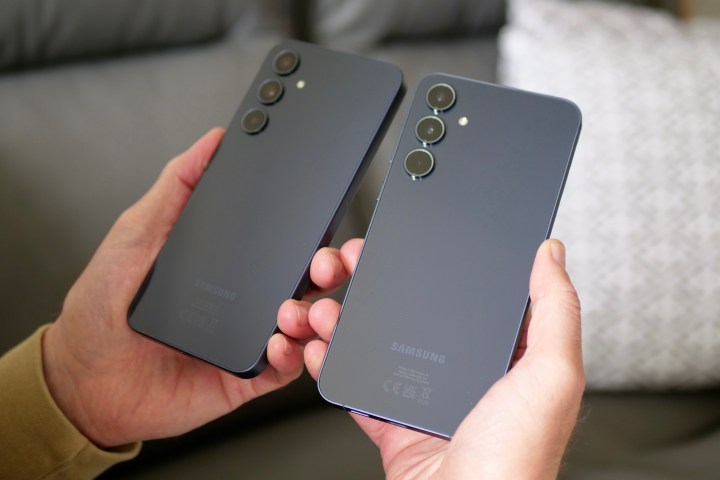
I’m in the process of reviewing the Galaxy A35, so I can’t comment on any performance differences between them yet, as there are subtle internal changes that may affect how the Galaxy A35 compares to the Galaxy A55 when used daily. However, the Galaxy A55 needs to be considerably better, as the Galaxy A35 has two big advantages over it that come directly from the materials used for each one. As we’ve established, they look practically the same even with moderately close examination, so when the cheaper model takes an early lead, it should make every bargain hunter pay attention.
My big problem with the Galaxy A55 concerns the sharp edges and how uncomfortable the phone can be to hold for extended periods of time. The glass and metal meet without any curve or chamfered edge to soften it, and you immediately notice it when you pick the phone up. Obviously, it’s not going to slice your hand open — it’s just not an ergonomically pleasing experience. At 213 grams, the Galaxy A55 is not heavy, but it is heavier than the Galaxy A54, and extra weight is not welcome considering the sharpness of the body.

The Galaxy A35 avoids all this despite looking like exactly the same phone. The glass meets the plastic chassis without the harsh sharp edge, and it’s much more comfortable to pick up and hold. No, it doesn’t feel quite as good as holding a metal frame, but I’ll take the tiny difference when I can bear to have it in my hand for longer than 10 minutes. The plastic frame shaves 4 grams off the weight, too, making the Galaxy A35 209 grams. It’s still heavier than the old 199-gram Galaxy A34, though.
Much of a spec compromise?
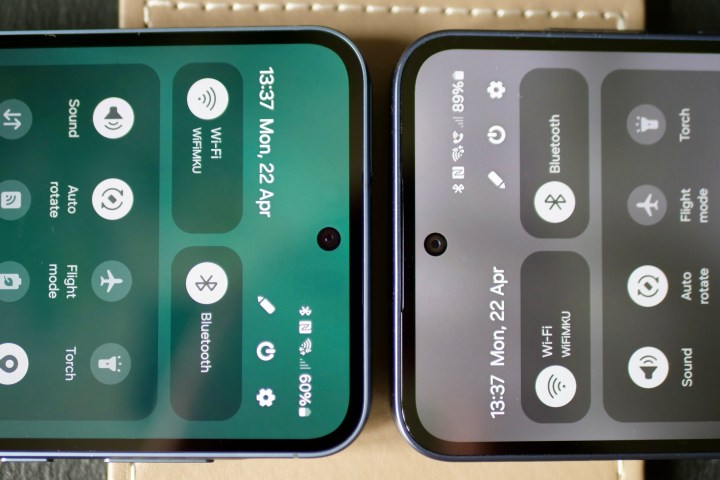
The Galaxy A35 is more comfortable to hold than the Galaxy A55, and that is going to make it a more pleasurable phone to own. But what about those spec differences? There isn’t all that much between them, with the major changes coming down to the processor, RAM, and wide-angle camera. The 8-megapixel wide-angle on the Galaxy A35 will inevitably be poor quality, but it’s not like the 12MP wide-angle camera on the Galaxy A55 is very good. Plus, the difference between 6GB and 8GB of RAM may not be hugely impactful all that often, either.
I’ll come back to the processor in my full review, but the Galaxy A35’s Exynos 1380 chip was good enough for the Galaxy A54, so it should be decent here. I don’t need any time testing the Galaxy A35 to understand the final difference that’s noteworthy, though: It costs less than the Galaxy A55, and as I’m already discovering, paying the additional cost mostly results in owning a phone with a sharp, stabby frame to hold.
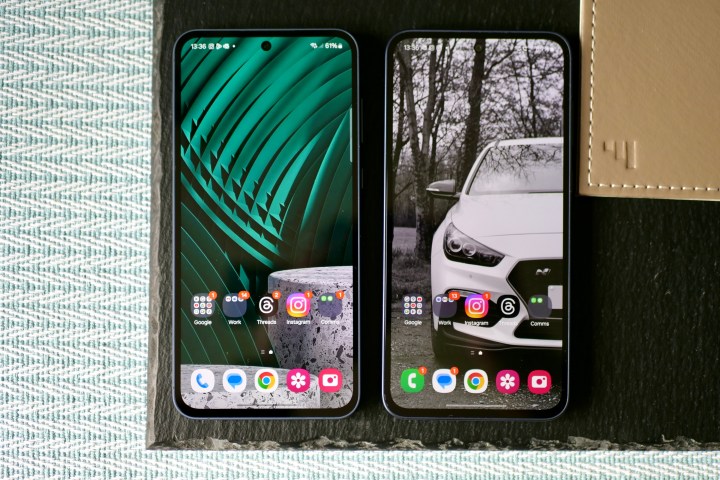
However, if you live in the U.S., the price difference is moot as Samsung has decided to only release the Galaxy A35 and not the Galaxy A55. Before trying the two phones, this seemed to be a bad thing, yet just a few hours into using the Galaxy A35, I’ve already changed my mind. The Galaxy A35 is on its way to being the better purchase out of the two, and being able to recommend it over the Galaxy A55 will make me very happy indeed.
Look out for our Samsung Galaxy A35 review very soon, when we’ll be able to finalize whether it’s the new A-series to buy. In the meantime, our Samsung Galaxy A55 review is available if you want a closer look at that model.
Editors' Recommendations
- Galaxy AI is coming to more Samsung phones very soon
- 5 ways the Samsung Galaxy S24 beats the Google Pixel 8
- Every Samsung gadget we still expect in 2024
- I have Samsung’s newest cheap phone, and I’m a bit worried
- A surprise phone just beat the Galaxy S24 Ultra in a big way



